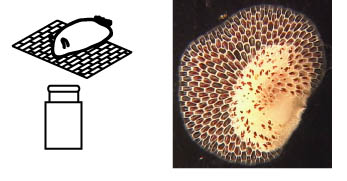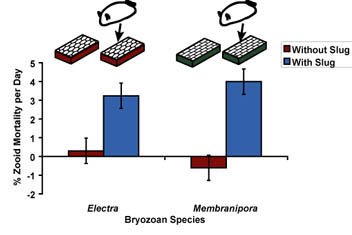Membranipora membranacea
An Invasive Bryozoan in the Gulf of Maine
|
Invasive species can become dominant if they are released from predation,
outcompete prior residents, or occupy an open niche. The bryozoan Membranipora membranacea was introduced
into the Gulf of Maine in 1987 and within two years became the dominant
species living on kelps. Encrustation by Membranipora may increase
the likelihood of breakage of kelps, possibly leading to large changes
in the ecosystem.
I am interested in:
-
-
|
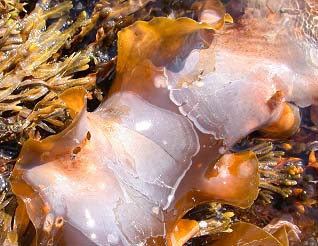
|
Back to Home Page
(1) How did Membranipora spread so quickly?
Some Possibilities:
- No predators or diseases
- There were unused resources (open niche)
- Membranipora is a better competiton
Predation
Where Membranipora is native, there tends to be a specialist
nudibranch (sea slug) predator that keeps the population in check. In
European populations, Polycera quadrilineata prefers
Membranipora while Onchidoris muricata is known
to prefer another bryozoan, Electra pilosa. Electra,
Membranipora, and Onchidoris are all now found in the
Gulf of Maine while Polycera is not.
Membranipora membranacea
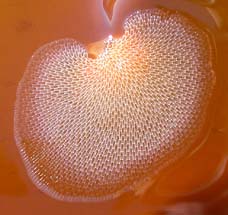
|
Onchidoris muricata
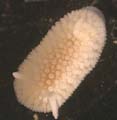
|
Electra pilosa
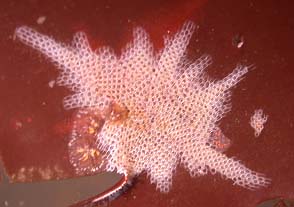
|
Bowdoin undergraduate honors student Emily Grason and I tested
1) Will Onchidoris eat Membranipora?
2) Does Onchidoris eat Electra or Membranipora faster?
3) Does Onchidoris prefer Electra or Membranipora?
Experimental Design
Onchidoris is a suctorial feeder, which means it eats the polypide
without destroying the entire zooid. Thus, it is possible to assess Onchidoris
feeding by measuring polypide mortality.We conducted "long term" experiments
where we counted the number of live polypides at 0, 4, and 11 days.
We also videotaped the slug eating at 1min intervals over 24h at 15-16ºC
to estimate a more accurate feeding rate for Onchidoris.
Results
1) Onchidoris will eat Membranipora
2) Onchidoris sometimes eats Membranipora faster
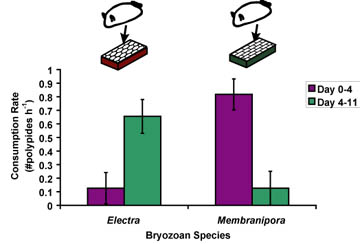
When not given a choice between bryozoan species:
Onchidoris ate Membranipora faster in the first 4
days,
but ate Electra faster in the next 7 days.
|
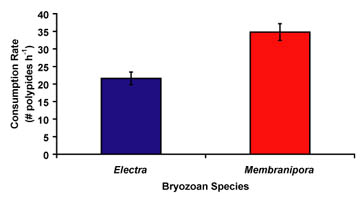
In the video, Onchidoris ate Membranipora
polypides significantly faster.
|
3) When given a choice, Onchidoris prefers Electra
While this experiment shows that at least one native predator will eat Membranipora,
the slug prefers another resident bryozoan when given a choice. Thus, one reason
why Membranipora was able to spread rapidly in the Gulf of Maine was
probably because it was essentially released from predation upon arrival.
Available Resources: Open Niche
Perhaps another reason Membranipora was able to spread so quickly
was because there were plenty of resources available (open niche). Before
Membranipora invaded the Gulf of Maine, not that many organisms
lived on kelps so it is possible that Membranipora was able to
establish and spread quickly because there was plenty of open substratum
to settle and grow on.
I measured the abundance and distribution of Membranipora and
Electra on four different species of seaweed (shown below) in
the low intertidal/upper subtidal over the course of the summer (2004).
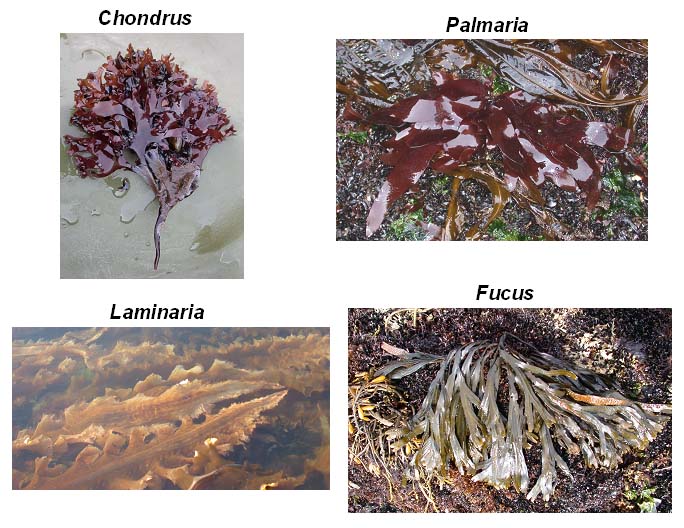
Results
Settlement of new colonies of Electra and Membranipora did
not occur until mid-July. Thus, I assumed that colonies present in
early June had survived the winter.
Electra does best on Chondrus: Electra survived on
50% of the Chondrus plants over winter and by September, Electra
had the highest percent cover on Chondrus. Membranipora does
not appear to settle on Chondrus in the field, maybe because there
is no space available during settlement.
Electra and Membranipora both survive the winter on Palmaria:
in June, 50% of the Palmaria examined had Electra present
and 25% had Membranipora present. When present, each bryozoan covers
~5% after the winter, which means that there were more small Electra
and fewer larger Membranipora on Palmaria in June. Membranipora
grows faster over the summer than Electra (by September Membranipora
has 2.5 times more percent cover than Electra).
Neither bryozoan survived the winter on either of the brown seaweeds (Fucus
and Laminaria). This is not surprising since Fucus tends
to be found a little higher in the intertidal and is exposed to the air,
and thus to freezing temperatures, on more tides during the winter. Laminaria
blades do not survive the winter well; new blades are grown each spring
from the holdfasts that survive the winter. New settlement of Membranipora
and Electra occurred in mid-July: by August, 100% of Laminaria
and 88% of the Fucus had Membranipora present, but only
15% of the Laminaria and 42% of the Fucus had Electra present.
By the end of the summer, Membranipora covered 77% of the Laminaria
and 50% of the Fucus, while Electra only covered 7% of
the Laminaria and 55% of the Fucus. Membranipora had
much higher settlement and the colonies probably grew faster.


Overall, these data show that Electra has higher winter
survival, but that Membranipora dominates in the late summer and early
fall. The other interesting point to note is that Membranipora does
not settle on the algae where Electra has high winter survival and covers
a large percentage of the algal blades (Chondrus), but Membranipora
has very high settlement on algae where there is no previous residents (Fucus
and Laminaria). In addition, where both bryozoan species are present
(either by winter survival or concurrent settlement), Membranipora dominates
by the end of the summer/early fall, suggesting that Membranipora has
a higher growth rate and outcompetes Electra for space. I did observe
many cases where Membranipora was growing over Electra. Electra's
long term survival may be largely dependent on Chondrus acting as
a refugium allowing higher winter survival.
Competition
Where Membranipora and Electra interact, Membranipora
tends to take up most of the available attachment space by having much higher
settlement and faster growth rates. Click here for
a PDF containing part of a recent talk given at the annual meeting for the
Society for Integrative and Comparative Biology in Orlando, Florida that gives
results comparing growth, feeding, and respiration rates of these two bryozoans.
Back to Top
(2) Consequences of Membranipora
invasion
Predation
Onchidoris typically reproduces in the spring and
grows over the winter (as diagrammed below), but has recently been found
reproducing in the winter in New Hampshire (L. Harris, University of
New Hampshire, personal communication).
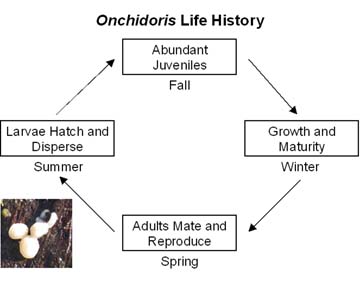
While Membranipora is the dominant epiphyte in the
late summer and fall, it does not survive the winter as well as Electra.
Thus, it will be interesting to see if Onchidoris maintains
its current life-history pattern and continues to concentrate on eating
Electra, or if the life cycle shifts so that it can take advantage
of the large Membranipora food source in the summer and fall.
Because of the huge supply of Membranipora in the late summer
and through the fall, if Onchidoris starts to take advantage of Membranipora
as a food source this could cause a population explosion of Onchidoris.
Many other indirect effects could result from such a population explosion
such as increased predation on Electra and other bryozoans or an
equal population explosion of predators of Onchidoris (note: it is
currently not known what if anything eats Onchidoris).
Ecosystem Changes
When a population of invasives spreads quickly, large ecosystem changes
can result. The addition of Membranipora may have direct (as
discussed above with an increase in the predator population) or indirect
effects on the food web. Food webs in the western North Atlantic generally
have four trophic levels, with large predatory fish at the top, invertebrate
predators such as lobsters and crabs at the second highest level, herbivorous
sea urchins at the second lowest level, and seaweeds at the bottom. Evidence
gathered by Robert Steneck, from the University of Maine's Darling Marine
Center, and colleagues suggests that The Gulf of Maine has gone through three
phases:
(1) Phase One: Predatory Fish Dominate
Phase one had stable populations of cod and other predatory fish that kept
down the population of lobsters, crabs, and urchins, which allowed lush
kelp beds to develop. (lasted from ~4000 years before present to the mid
1960s)
(2) Phase Two: Herbivorous Sea Urchins Dominate
Phase two was characterized by a reduction in predatory fish populations
(because of heavy fishing), an expansion of urchins (since their predators
had decreased), and a decline in kelps (since the large urchin population
was eating all the kelp). Large aggregations of urchins ate all the
seaweeds leaving only a crust of coralline algae (this is called an urchin
barren). (lasted from ~1970-1990)
(3) Phase Three: Predatory Invertebrates Dominate
In 1987, intense harvesting of urchins began and kelp beds began to reestablish.
Predatory crustaceans take refuge in the kelp beds and eat any urchins
that settle or are reintroduced by humans. Thus, phase three is dominated
by crustaceans and kelp. (began in mid 1990s)
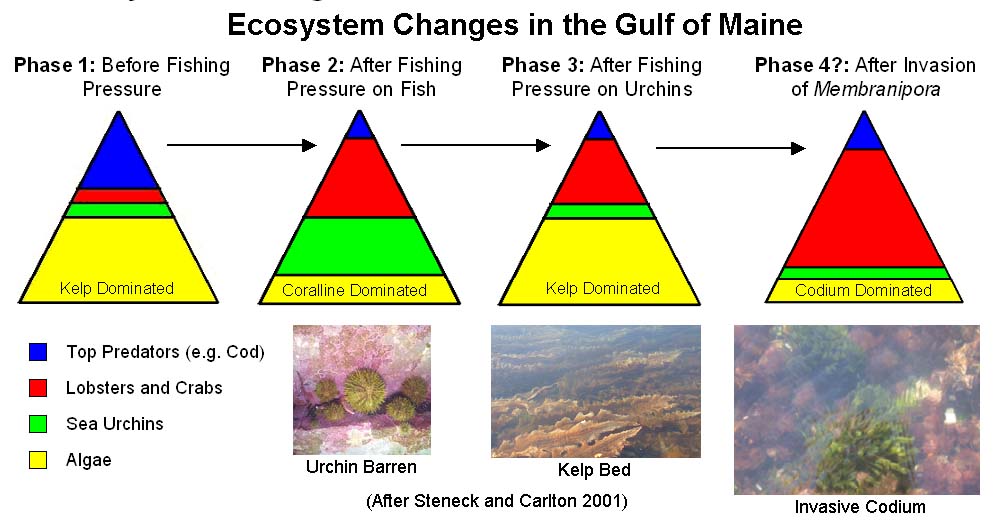
Phase one was stable for a much longer time than phase 2. While
we appear to still be in Phase 3, evidence is mounting that another shift
maybe be occurring, which would make phase 3 even shorter than phase 2. The
question is, will Phase 3 continue or will there be another shift? If
there is another shift, what state will it shift to?
Membranipora appears to decrease kelp growth and survival. Gaps
in kelp beds result from the breakage of kelp blades, and this allows an
invasive species of green algae, Codium fragile, to recruit. Codium
is unable to recruit in dense kelp beds because the kelp canopy shades
the shorter Codium plants, but once a gap opens up Codium is
able to successfully recruit. Once Codium is established, the
kelps are not able to recruit and there is a gradual turnover from kelp
to Codium domination.
As a consequence of the Membranipora invasion, there may be shift
to a Phase 4 that is dominated by Codium. The canopy of Codium
is still likely to harbor predatory crustaceans. With predators
present and less kelp available, the urchins population is not likely to
increase even if pressure from fishing is reduced dramatically. More
research is needed to determine if the ecosystem is really shifting, what
is causing the shift, and what state the system is shifing to.
Back to Top






